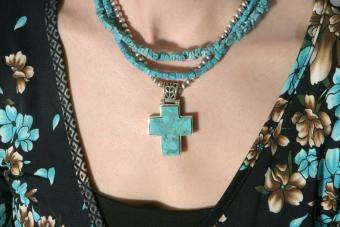
Emerald jewelry must have been part of Cleopatra's fascination; not only were her emerald mines famous, but when Rome dictated its surrender terms, she was ordered to give up her jewelry. The serene mystery of emeralds has bedecked the wardrobe of many a fascinating woman (and more than a few men) both before and ever since then.
Buying Emerald Jewelry
Emeralds come in a wide shade of greens, from yellow-green to blue-green. The most valuable is grass green with a hint of blue, but you may find that a different shade pleases you as much or even more. The intensity and brightness of the color also affect the monetary value.
Because emeralds almost always have internal flaws, the value of the stone increases dramatically with its size, far more so than for many other gems. Stones over five carats are rare and ones over seven are extremely rare.
Nearly all emeralds set in jewelry have been oiled to fill internal fractures and some have been filled with colored epoxies. These are both standard treatments although the jeweler should still disclose them.
Simulants and Imitations
There are only two major lab-grown emeralds, Chatham and Gilson. Chathams are quite expensive, though still far cheaper than natural emeralds of similar quality. Simulants (imitations rather than chemically identical but synthetic) include colored glass and aquamarine or quartz layered with green cements.
Styles
Solitaire emeralds are most common in rings or earrings because of their small size. Because the natural color variations of emeralds complement one another, however, you can cluster them together for very striking pendants, necklaces, or bracelets.
Almost any shade of emerald goes very well with yellow gold. It takes an intense, bright emerald to go well with white metals such as platinum or white gold, but this combination can display an almost unparalleled sophistication.
Diamonds are the most common accent stone in emerald jewelry, but don't limit yourself to this by any means. During the Art Deco period, the famous firm Cartier introduced the tutti frutti or fruit salad style, a rich combination of emeralds, rubies, and sapphires that was influenced by (Asian) Indian jewelry, and this remains a tremendously luxurious look. If your budget doesn't run to that, semi-precious stones are another great option; try amethyst, garnets, citrines,
Taking Care of Emerald Jewelry
Never clean emerald jewelry in an ultrasonic cleaner, unless you really, really enjoy the suspense of waiting to see if the internal flaws made the stones shatter! Avoid soapy water, too, since that can wash away any filler oils.
Emeralds are harder than many other stones, but because of those internal flaws, can break if you hit them against something along a flaw line. Be particularly careful of hitting an exposed corner against something.
Beliefs about Emeralds/Famous Emeralds
Emeralds are the May birthstone. Some believe that emeralds enhance one's mental abilities; that they bring one closer to the powers of nature; or that they make childbirth easier. These beliefs were likely inspired by their green color, which associates them with nature, fertility, and life. They are also common in crucifixes for this same reason.

Because green is the color of Islam, there are many famous emeralds carved with verses from the Koran, most notably the Mogul emerald. The royal jewels of England include the Cambridge and Delhi Dunbar Parure, an astonishing set of emerald jewelry. The Smithsonian gem collection includes the Hooker Brooch (no, no, the donor was named Hooker) and the Inquisition Necklace (from the era of the Inquisition).







